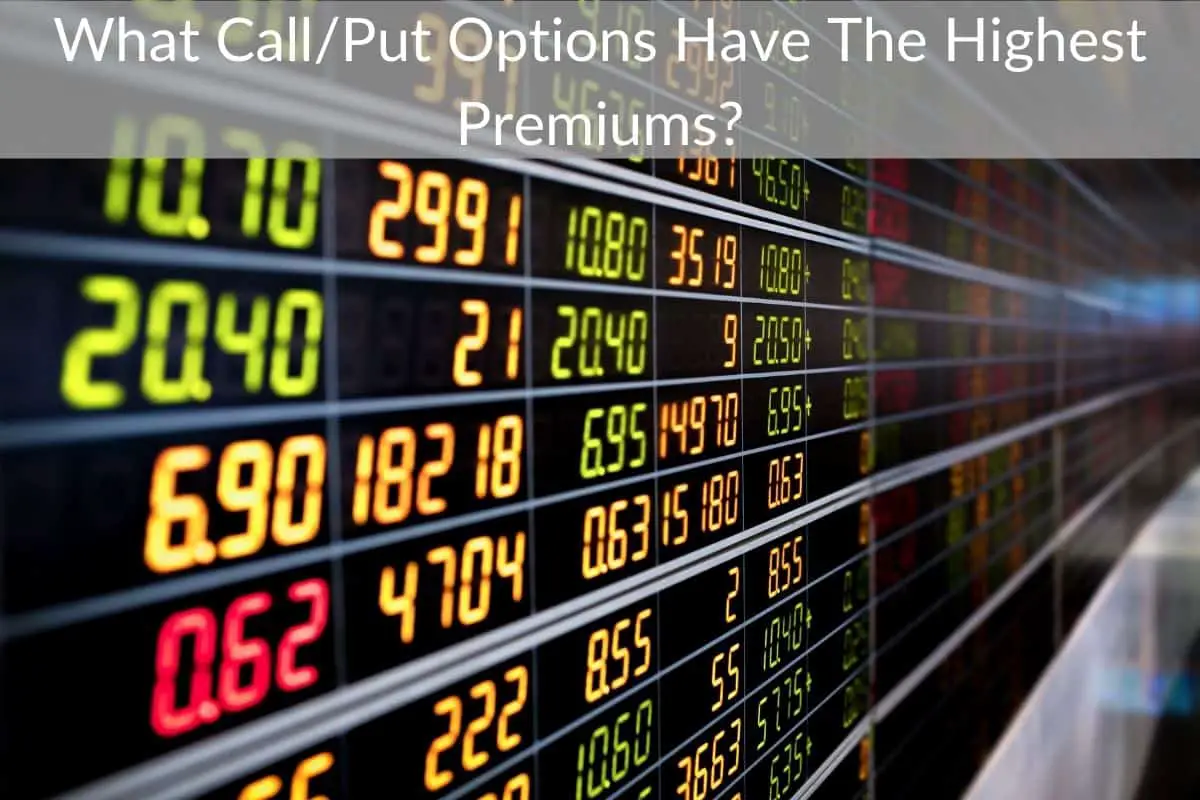Table of Contents
*This post may contain affiliate links. As an Amazon Associate we earn from qualifying purchases.
The premiums of call and put options depend on various factors, such as moneyness, intrinsic & extrinsic values, underlying assets’ spot prices, volatility, and other metrics.
These metrics’ in real-time and anticipated changes determine if a call or put option will have a high premium.
Put options for assets that have a significant intrinsic value have high premiums. Call options for volatile assets have a substantial extrinsic value, thus high premiums.
Generally, deep in the money options and high implied volatility increase an option premium.
The metrics influencing an option premium’s profitability are dynamic. Since these values change as options contracts are executed or eventually expire, you must heed the telltale signs to decide timely.
This guide discusses the most critical factors affecting option premiums.
How Does Moneyness Affect Call/Put Options Premiums?
Moneyness is the financial correlation of an underlying asset’s spot price with an option’s strike price. Generally, moneyness is calculated as the difference between the real-time market price and the strike price of a call or put option.
Moneyness is defined or described in 3 ways:
- In the money (ITM)
- Out of the money (OTM)
- At the money (ATM)
In the money options have significant intrinsic values, which means the strike price is substantially greater or less than the spot price for a put or call option, respectively.
Let’s consider a few examples:
- An underlying asset A has a spot price of $100.
- Its put option X has a strike price of $150.
- This particular put option has significant moneyness and is deep in the money.
The enormous difference shown here is the low market price for an asset that’s otherwise estimated as valuable.
Thus, its intrinsic value is high.
However, the same moneyness is inversely applicable if this example is for a call option. The call option, in this case, is out of the money because a buyer pays more than the market price.
A call option Y with a $150 strike price for the underlying asset A with a $100 spot price implies the buyer is spending $50 more than the stock’s current value. If the spot price is $150 and the strike price is $100, asset A’s call option will be deep in the money.
If the spot price and the strike price of a call or put option are the same, the contract has an at the money premium. In the cited example, suppose the call X or put Y for the asset A with a $100 spot price has a strike price of $100. In that case, the call or put is an at the money option.
Moneyness can affect call/put options premiums because premiums become more expensive when they involve an in the money call or put option. On the other hand, an out of the money call or put option will have a smaller premium since the option is less likely to get exercised.
Tesla (TSLA) options have high premiums based on moneyness and implied volatility. If you refer to this chart, TSLA options premiums range as high as $1,225, significantly more than the stock’s current trading price.
American Airlines Group (AAL) options are further in the money and out of the money than that of Tesla. Although most AAL options being traded are near or at the money, the spread for both calls and puts are as much as +/- 25%.
How Do Historical & Implied Volatilities Affect Option Premium?
You can determine the historical volatility of an asset based on data. The statistical evidence makes historical volatility more reliable.
Implied volatility is based on market factors, including popular sentiment and probability. Thus, implied volatility has a greater impact on call and put option premiums.
Option premiums are directly proportional to implied volatility. However, the intrinsic and extrinsic values of put and call options don’t change similarly due to implied volatility.
A specific call or put option’s moneyness depends on many pertinent factors.
Options are derivatives. Thus, two types of implied volatilities are at play. The first kind is about the presumed or assessed volatility of the underlying asset, and the second kind is the implied volatility of a particular options contract.
The demand for a call or put option can rise depending on market factors. This surge can lead to a change in the implied volatility of the option contract. However, such a development may or may not be entirely based on the actual assessment of the underlying asset’s true volatility.
Stock prices fluctuate often based on the assessment of market factors, including the impact of trading. Likewise, an option contract, whether call or put, may become volatile solely due to the prices and not based on fundamentals.
Let’s use the above example of asset A with a spot price of $100 and its put option having a strike price of $150. Other than a significant intrinsic value or moneyness, implied volatility could contribute to the vast difference between the spot and strike prices.
Like Tesla, Netflix (NFLX) has high options premiums. However, Netflix has fewer historical and implied volatilities. Thus, deep in or out of the money options for Netflix are not popular among traders and investors.
As this chart shows, more trades have premiums closer to at-the-money.
How Does Time Value Affect Option Premium?
Time value is primarily derived from the remaining duration of an options contract. An integral part of the extrinsic value, the time left for the holder of an option to buy or sell, can influence the premium.
Like moneyness, this effect is also inverse for call and put options.
Time value affects option premium because the longer the contract has before it expires, the higher the option’s premium is. Both time value and implied volatility are a combined reason.
If an options contract is long, there’s more implied volatility and thus many possible changes in the underlying asset’s price.
Time value is assessed using moneyness and implied volatility.
If an option is in the money, a longer contract may not be desirable because the low, current spot price may catch up to the high strike price.
Inversely, an out of the money contract with more time left is desirable because the underlying asset may undergo favorable changes, depending on whether you call or put.
It’s necessary to note that implied volatility doesn’t indicate the direction of the changes but merely fluctuations of an underlying asset’s value or the popularity of an options contract.
Final Thoughts
Implied volatility, which is considerably based on recent events, profoundly impacts option premiums, irrespective of call or put. Time value is another significant element that is generally applicable for all options.
Moneyness is more case-specific.
How you assess these influencing factors depends on your primary objective and the option type. As elaborated in this guide, the same metrics have varying effects on the viability and profitability of call and put options.
Do a thorough analysis for an option before you decide.

